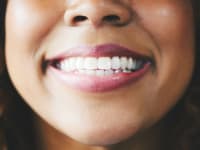7 ways to take care of your teeth when you can't go to the dentist
Keep your teeth happy and strong with an expert's tips.
Products are chosen independently by our editors. Purchases made through our links may earn us a commission.
Taking care of your teeth is always important, but proper dental health is even more important now that dental cleanings may be cancelled due to the coronavirus. You likely (and hopefully) already have the tools needed for basic oral hygiene, like a toothbrush and floss, but maybe you don’t know why these tools are necessary or how to make the most out of them. We spoke to Dr. Ada Cooper, DMD, a dentist based in New York City and spokesperson for the American Dental Association (ADA), to get an expert’s tips for taking care of your teeth at home.
1. Get a quality toothbrush—and use it correctly
There are certain non-negotiables when it comes to at-home dental care. The first one is obvious: A toothbrush. “Whether it's manual or powered, your teeth really don't care. You just need to use it and use it correctly,” Cooper says. “When it comes to choosing a brush, be sure it’s 'soft.' 'Firm' or even ‘medium’ bristles can cause damage to your gums.”
Make sure you don’t scrub vigorously—you want to clean your teeth, but not at the expense of your gums and tooth enamel, which can weaken from too much pressure or friction from improper brushing. The ADA recommends you hold the brush at a 45-degree angle from your gums and gently sweep back and forth. This angle helps to get buildup out that’s trapped between your gums and your teeth. Make sure you get the tops and sides of each tooth, focusing on one quadrant of the mouth at a time until you’ve eventually covered the whole mouth. The recommended time you spend as a whole is two minutes, or 30 seconds per quadrant. You should do this at minimum twice a day—once in the morning either before or 30 minutes to an hour after breakfast (you may end up brushing enamel-weakening acid from the food around your mouth if you brush directly after eating) and at night, right before bed.
When you’re storing your toothbrush, don’t routinely put a cover on it, as this will trap moisture in and create a breeding ground for bacteria. Replace your toothbrush, or the head on an electric model, every three to four months to make sure your bristles are fresh and at the proper strength to do their job.
If you’re in the market for a new electric toothbrush, our favorite after testing is the Oral B Pro 3000, which features a two-minute timer that cues you every 30 seconds to change quadrants. It also has a visible pressure sensor that lights up red when you bear down too hard to keep you from damaging your teeth and gums.
Get the Oral B Pro 3000 on Amazon for $67.24
2. Use a toothpaste with fluoride
The ADA recommends using a toothpaste that includes fluoride, a mineral in your bones and teeth, as an ingredient. “Not all toothpastes contain fluoride, but you should always use one that does contain it,” Cooper says. “Fluoride is a natural cavity fighter that helps to strengthen the tooth enamel and fight tooth decay.” (Though there’s some controversy over the safety of excess fluoride use, the current science supports that it does more good than harm in dental products like toothpaste and mouthwash, as long as the products are used as directed and not ingested.)
Depending on certain needs or wants, you may also look for other active ingredients. For example, you may want a toothpaste that whitens your teeth and removes stains, for which common ingredients include baking soda and hydrogen peroxide. The best way to learn about subcategories of toothpaste that may work for you is to speak to your dentist about your concerns. When you’re shopping for a toothpaste, Cooper says you should look for the ADA seal of acceptance, which serves as a sign that the toothpaste contains the appropriate ingredients to do what it claims.
3. Don’t skimp on flossing
If you’ve ever been called out by your dentist for not flossing enough, you’re not alone. But skipping this step on the regular is detrimental to your dental health. “Brushing and flossing accomplish two different things and that’s why they’re both essential,” Cooper says, though she points out the order in which you do them isn’t important. “Flossing before brushing, brushing before flossing, it doesn’t matter to your teeth as long as you do both.”
Brushing removes the plaque and food buildup on your teeth, but flossing—or using another interdental cleaning tool like a water flosser—removes the buildup between your teeth, where your brush can’t go.
If you don’t mind string floss, stock up on some with the Oral B Glide Dental Floss, which claims to be “shred-resistant,” and more than 2,000 reviewers agree that it’s great.
Some people prefer to floss with picks, which have pre-strung floss that’s less fussy and messy to use. A pack of DenTek Triple Clean Floss Picks contains 150 fluoride-coated picks that claim to be break-resistant “even when used on the tightest of teeth.”
For those who really dislike flossing, consider a water flosser like this one from Waterpik, which uses a thin jet of water in place of floss string to clean between teeth. Our reviewer was impressed with its sleek design and how easy it was to use even on the first try.
- Get the Oral B Glide Dental Floss (6 pack) on Amazon for $10.50
- Get the DenTek Triple Clean Floss Picks on Amazon for $3.64
- Get the Waterpik Aquarius Water Flosser on Amazon for $69.99
4. Keep your diet in mind
You know that gorging on candy is bad for your teeth, but what and how you eat, and the effect it has on your oral hygiene, is more nuanced than that. “For good dental health, you should carefully choose your meals and your snacks,” Cooper says. “Eat a variety of foods from each of the major five food groups.” Eating a balanced diet affects your teeth because your body is better equipped to resist infections that could lead to gum disease. And, more directly, if you eat too many sugary or carb-loaded foods, you risk breaking down your tooth enamel.
Cooper also recommends that if you’re going to eat snacks throughout the day, you don’t graze over them. “Continuously snacking throughout the day can actually increase the likelihood that you’ll develop cavities,” Cooper says. This is because the bacteria in your mouth breaks down carbohydrates found in snacks like candy or starches into acid that then causes cavities. The longer the carbs sit in your mouth, the more acid will be created. Brushing your teeth or using mouthwash after every snack or meal is unnecessary, but washing your food down with water as you eat and especially after you’re done is enough to aid in unwanted cavities. You may also chew sugar-free gum after eating (more on that below).
5. Understand the benefits and limitations of mouthwash
Cooper cautions that mouthwash is not a substitute for brushing or flossing, but it can prevent tooth decay, reduce plaque, and prevent the early stages of gum disease. Bonus: It’s a great way to freshen your breath.
As for who should use mouthwash, Cooper says that if you have a healthy mouth, it can be a great adjunct product. If you're 65 or older and/or struggle with teeth health, though, mouthwash may camouflage important symptoms without actually treating them. For example, an infection in the mouth like periodontitis may cause your breath to smell stronger than normal, but you may not notice this if you frequently use mouthwash that masks the symptom. The best thing you can do is talk to your dentist if you’re interested in incorporating mouthwash into your routine.
If you get the green light to use a mouthwash, you can again look for the ADA seal of acceptance when shopping for one. “There are two different types of mouthwashes, therapeutic and cosmetic,” Cooper says. “Therapeutic mouthwashes kill bacteria and contain active ingredients that your doctor may feel are appropriate for you. Cosmetic washes mostly temporarily reduce bad breath and can leave your mouth with a pleasant taste, but they don’t really decrease your risk of cavities.” Some therapeutic mouthwashes must be prescribed by a doctor, which highlights again the importance of speaking to your dentist if you're trying to tackle a particular problem with mouthwash.
6. Use a tongue scraper if you want
Another common dental product is a tongue scraper, which adds a step to your oral health routine—these devices are O-shaped plastic or U-shaped metal tools that remove debris from the surface of your tongue. However, “there’s no clinical evidence that brushing or scraping your tongue will prevent bad breath or improve chronic bad breath and, in fact, bacteria can grow back just as fast as you remove it,” Cooper says. “But having said that, if you like the way your mouth feels after you clean your tongue, keep it up, by all means.”
7. Chew sugarless gum—if your dentist is on board
Lastly, Cooper says some patients ask about the benefits and risks of chewing sugarless gum. “Clinical studies have shown that chewing sugarless gum between and following meals can help prevent tooth decay,” she says. It helps increase saliva, which washes away food and other debris. “Saliva neutralizes acid that’s produced by bacteria in the mouth and it can increase the production of calcium and phosphate, which can help strengthen the tooth enamel,” Cooper says.
That said, if you have bridges, crowns, or braces, chewing gum likely isn’t a great option for you as it can get stuck in or break down the restorations, so you should speak to your dentist before you pick up a pack of Trident.


